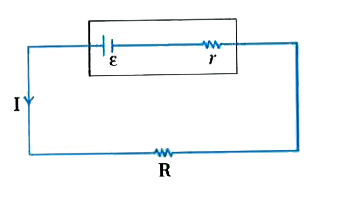When electrons drift in a metal from lower to higher potential, does it mean that all the 'free' electrons of the metal are moving in the same direction ? Solution in Gujrati
No, drift velocities of all the free electrons are not in the same direction because free electrons have to move in the direction of resultant velocity which is a superposition of drift velocity and thermal velocity.
Topper's Solved these Questions
- CURRENT ELECTRICITYBOOK - KUMAR PRAKASHANCHAPTER - CURRENT ELECTRICITYEXERCISE - SECTION [B] (NUMERICAL FROM TEXTUAL EXERCISE)
35 Videos
- CURRENT ELECTRICITYBOOK - KUMAR PRAKASHANCHAPTER - CURRENT ELECTRICITYEXERCISE - SECTION [B] (NUMERICAL FROM .DARPAN. BASED ON TEXTBOOK)
13 Videos
- CURRENT ELECTRICITYBOOK - KUMAR PRAKASHANCHAPTER - CURRENT ELECTRICITYEXERCISE - SECTION [A] TRY YOURSELF
74 Videos
- BOARD'S QUESTION PAPER MARCH-2020 BOOK - KUMAR PRAKASHANCHAPTER - BOARD'S QUESTION PAPER MARCH-2020 EXERCISE - PART-B SECTION -C
4 Videos
- DUAL NATURE OF RADIATION AND MATTERBOOK - KUMAR PRAKASHANCHAPTER - DUAL NATURE OF RADIATION AND MATTEREXERCISE - Section-D (MCQs asked in GUJCET/Board Exam)
1 Videos
Similar Questions
The storage battery of a car has an emf of 12 V. If the internal resistance of the battery is 0.4 Ω , what is the maximum current that can be drawn from the battery ?

View SolutionThe current through a wire varies with time as I=I0+αt, where I0=10 A and α=4As−1 . The charge that flows across a cross-section of the wire in first 10 seconds is .....
View SolutionWhat is reason behind producing electric force between two particles ?
View SolutionDerive an expression for current I passing through an AC circuit containing only inductor L. Draw a Phasor diagram and graph of v and I versus ωt. Explain instantaneous power and the average power.
View SolutionMass of photon in motion is ………
View Solution(a) In Example 3.1, the electron drift speed is estimated to be only a few mm s^(-1) for currents in the range of a few amperes? How then is current established almost the instant a circuit is closed? (b) The electron drift arises due to the force experienced by electrons in the electric field inside the conductor. But force should cause acceleration. Why then do the electrons acquire a steady average drift speed? (c) If the electron drift speed is so small, and the electron’s charge is small, how can we still obtain large amounts of current in a conductor? (d) When electrons drift in a metal from lower to higher potential, does it mean that all the ‘free’ electrons of the metal are moving in the same direction? (e) Are the paths of electrons straight lines between successive collisions (with the positive ions of the metal) in the (i) absence of electric field, (ii) presence of electric field?
View Solutionwhen electrons drift in a metall from lower to higher potential does it mean that all the free electrons of the metal are moving in the same direction?
View Solutionजब इलेक्ट्रॉन किसी धातु में कम विभव से अधिक विभव की और चलते है तो क्या धातु के सभी इलेक्ट्रॉन एक ही दिशा में चल रहे होते है ?
View SolutionA free electron moves from a higher to a lower potential. Is the statement correct?
View Solutionकिसी चालक के सिरों पर विभवान्तर आरोपित करने पर इसमें प्रवाहित होती है। क्या इसका यह तात्पर्य है कि सभी मुक्त इलेक्ट्रॉन्स एक ही दिशा में गति कर रहे है?
View SolutionWhen electrons in a metal are driven down to a higher potential, does it mean that all the 'free' electrons in the metal are moving in the same direction?
View Solution(a) the electron drift speed is estimated to be only a few mm s ^(-1) for currents in the range of a few amperes ? How then is current established almost the instnat a circuit is closed ? (b) The electron drift arises due to the force expectenced by electrons in the electric field inside the conductor. But force should cause acceleration. Why then do the electrons acqutre a steady average drift speed ? (c ) If the electron drift speed is so small, and the electrons's charge is small, how can we still obtain large amounts of current in a conductor ? (d) When electrons drift in a metal from lower to higher potential, does it mean that all the 'free' electrons of the metal are moving in the same direction ? (e) Are the paths of electrons straight lines between successive collisions (witht the positive ions of the metal) in the (i) absence of electric field, (ii) presence of electric field ?
View Solution(a) the electron drift speed is estimated to be only a few mm s ^(-1) for currents in the range of a few amperes ? How then is current established almost the instnat a circuit is closed ? (b) The electron drift arises due to the force expectenced by electrons in the electric field inside the conductor. But force should cause acceleration. Why then do the electrons acqutre a steady average drift speed ? (c ) If the electron drift speed is so small, and the electrons's charge is small, how can we still obtain large amounts of current in a conductor ? (d) When electrons drift in a metal from lower to higher potential, does it mean that all the 'free' electrons of the metal are moving in the same direction ? (e) Are the paths of electrons straight lines between successive collisions (witht the positive ions of the metal) in the (i) absence of electric field, (ii) presence of electric field ?
View SolutionThe drift velocity of free electrons in metals is of the order of_______.
View SolutionWhen electrons drift in a metal from lower to higher potential, does it mean that all the free electrons of the metal are moving in the same direction ?
View Solution
